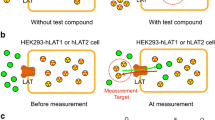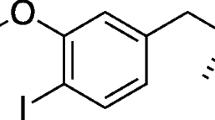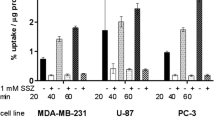Abstract
Purpose
The present study describes the analysis of amino acid transporters ASCT1, ASCT2, LAT1, and xc− in breast cancer under normoxic and hypoxic conditions. [18F]FDOPA-PET and [18F]FSPG-PET were used as imaging biomarkers to probe l-type amino acid transporter (LAT1) and cystine-glutamate antiporter (xc−) in breast cancer models.
Procedures
LAT1 and xc− transporters were studied under normoxic and hypoxic conditions with radiotracers [18F]FDOPA and [18F]FSPG in estrogen receptor–positive (ER+) MCF7 and triple-negative MDA-MB231 cells and in human mammary epithelial MCF10A control cells. Protein expression was analyzed using Western blot and immunohistochemistry.
Results
ASCT1 protein expression levels were comparable in all three cell lines, while noticeable ASCT2 expression levels were only found in MCF10A control cells. Higher LAT1 protein expression was detected in ER+ MCF7 cells. High xc− protein expression levels were detected in MDA-MB231 cells. Uptake of [18F]FDOPA through LAT1 was significantly higher in MCF7 versus MDA-MB231 cells, while the uptake of [18F]FSPG through xc− resulted in the opposite confirming expression and functional differences for both amino acid transporters in different breast cancer models. Hypoxia significantly increased [18F]FDOPA uptake in MCF7 cells and [18F]FSPG uptake in MDA-MB231 cells. In vivo PET imaging revealed substantially higher tumor uptake of [18F]FDOPA in MCF7 tumors as well as [18F]FSPG uptake in MDA-MB231 tumors confirming differences detected in vitro.
Conclusions
ER+ breast cancer cells express higher levels of amino acid transporter LAT1, whereas triple-negative breast cancer cells express more xc−. Cellular uptake and PET imaging experiments with [18F]FDOPA and [18F]FSPG confirmed functional LAT1 and xc− expression profiles. There was initial evidence that hypoxia regulates the function of both amino acid transporters in breast cancer. The results further indicated that [18F]FDOPA and [18F]FSPG are suitable radiotracer to distinguish between ER+ and triple-negative breast cancer types.





Similar content being viewed by others
References
DeSantis CE, Ma J, Goding Sauer A, Newman LA, Jemal A (2017) Breast cancer statistics, 2017, racial disparity in mortality by state. CA Cancer J Clin 67:439–448
Tevaarwerk AJ, Gray RJ, Schneider BP, Smith ML, Wagner LI, Fetting JH, Davidson N, Goldstein LJ, Miller KD, Sparano JA (2013) Survival in patients with metastatic recurrent breast cancer after adjuvant chemotherapy little evidence of improvement over the past 30 years characteristics of included trials. Cancer 119:1140–1148
Bychkovsky BL, Lin NU (2017) Imaging in the evaluation and follow-up of early and advanced breast cancer: when, why, and how often? Breast 31:318–324
Groheux D, Cochet A, Humbert O, Alberini JL, Hindie E, Mankoff D (2016) 18F-FDG PET/CT for staging and restaging of breast cancer. J Nucl Med 57(Suppl 1):17S–26S
Shen B, Huang T, Sun Y, Jin Z, Li XF (2017) Revisit 18F-fluorodeoxyglucose oncology positron emission tomography: ‘systems molecular imaging’ of glucose metabolism. Oncotarget 8:43536–43542
Alvarez JV, Belka GK, Pan TC, Chen CC, Blankemeyer E, Alavi A, Karp JS, Chodosh LA (2014) Oncogene pathway activation in mammary tumors dictates FDG-PET uptake. Cancer Res 74:7583–7598
Kubota K, Yamashita H, Mimori A (2017) Clinical value of FDG-PET/CT for the evaluation of rheumatic diseases: rheumatoid arthritis, polymyalgia rheumatica, and relapsing polychondritis. Semin Nucl Med 47:408–424
Adejolu M, Huo L, Rohren E, Santiago L, Yang WT (2012) False-positive lesions mimicking breast cancer on FDG PET and PET/CT. AJR Am J Roentgenol 198:W304–W314
Lieu EL, Nguyen T, Rhyne S, Kim J (2020) Amino acids in cancer. Exp Mol Med 52:15–30
Smith B, Schafer XL, Ambeskovic A, Spencer CM, Land H, Munger J (2016) Addiction to coupling of the Warburg effect with glutamine catabolism in cancer cells. Cell Rep 17:821–836
Cha YJ, Kim ES, Koo JS (2018) Amino acid transporters and glutamine metabolism in breast cancer. Int J Mol Sci 19:E907
Semenza GL (2015) The hypoxic tumor microenvironment: a driving force for breast cancer progression. Biochim Biophys Acta 1863:382–391
Hamann I, Krys D, Glubrecht D, Bouvet V, Marshall A, Vos L, Mackey JR, Wuest M, Wuest F (2018) Expression and function of hexose transporters GLUT1, GLUT2, and GLUT5 in breast cancer—effects of hypoxia. FASEB J 32:5104–5118
Elorza A, Soro-Arnáiz I, Meléndez-Rodríguez F, Rodríguez-Vaello V, Marsboom G, de Cárcer G, Acosta-Iborra B, Albacete-Albacete L, Ordóñez A, Serrano-Oviedo L, Giménez-Bachs JM, Vara-Vega A, Salinas A, Sánchez-Prieto R, Martín del Río R, Sánchez-Madrid F, Malumbres M, Landázuri MO, Aragonés J (2012) HIF2α acts as an mTORC1 activator through the amino acid carrier SLC7A5. Mol Cell 48:681–691
Barollo S, Bertazza L, Watutantrige-Fernando S, Censi S, Cavedon E, Galuppini F, Pennelli G, Fassina A, Citton M, Rubin B, Pezzani R, Benna C, Opocher G, Iacobone M, Mian C (2016) Overexpression of L-type amino acid transporter 1 (LAT1) and 2 (LAT2): novel markers of neuroendocrine tumors. PLoS One 11:e0156044
Sarikaya I (2015) PET imaging in neurology: Alzheimer’s and Parkinson’s diseases. Nucl Med Commun 36:775–781
Minn H, Kemppainen J, Kauhanen S, Forsback S, Seppänen M (2014) F-Fluorodihydroxyphenylalanine in the diagnosis of neuroendocrine tumors. PET Clin 9:27–36
Zhang JS, Li L, Cheng W (2016) Single incision laparoscopic 90 % pancreatectomy for the treatment of persistent hyperinsulinemic hypoglycemia of infancy. Pediatr Surg Int 32:1003–1007
Imperiale A, Sebag F, Vix M, Castinetti F, Kessler L, Moreau F, Bachellier P, Guillet B, Namer IJ, Mundler O, Taïeb D (2015) F-FDOPA PET / CT imaging of insulinoma revisited. Eur J Nucl Med Mol Imaging 42:409–418
Koglin N, Mueller A, Berndt M, Schmitt-Willich H, Toschi L, Stephens AW, Gekeler V, Friebe M, Dinkelborg LM (2011) Specific PET imaging of xC- transporter activity using a 18F-labeled glutamate derivative reveals a dominant pathway in tumor metabolism. Clin Cancer Res 17:6000–6011
Beinat C, Gowrishankar G, Shen B, Alam IS, Robinson E, Haywood T, Patel CB, Azevedo EC, Castillo JB, Ilovich O, Koglin N, Schmitt-Willich H, Berndt M, Mueller A, Zerna M, Srinivasan A, Gambhir SS (2019) The characterization of 18F-HGTS13 for molecular imaging of XC2 transporter activity with PET. J Nucl Med 60:1812–1817
Ermert J, Coenen HH (2013) Methods for (11) C- and (18) F-labelling of amino acids and derivatives for positron emission tomography imaging. J Labelled Comp Radiopharm 56:225–236
Coenen HH, Ermert J (2018) 18F-labelling innovations and their potential for clinical application. Clin Transl Imaging 6:169–193
Libert LC, Franci X, Plenevaux AR, Ooi T, Maruoka K, Luxen AJ, Lemaire CF (2013) Production at the Curie level of no-carrier-added 6-18F-fluoro-L-dopa. J Nucl Med 54:1154–1161
Wuest M, Kuchar M, Sharma SK, Richter S, Hamann I, Wang M, Vos L, Mackey JR, Wuest F, Löser R (2015) Targeting lysyl oxidase for molecular imaging in breast cancer. Breast Cancer Res 17:107
Krys D, Hamann I, Wuest M, Wuest F (2019) Effect of hypoxia on human equilibrative nucleoside transporters hENT1 and hENT2 in breast cancer. FASEB J 33:13837–13851
Van Geldermalsen M, Wang Q, Nagarajah R et al (2016) ASCT2/SLC1A5 controls glutamine uptake and tumour growth in triple-negative basal-like breast cancer. Oncogene 35:3201–3208
Shennan DB, Thomson J, Gow IF, Travers MT, Barber MC (2004) L-leucine transport in human breast cancer cells (MCF-7 and MDA-MB-231): kinetics, regulation by estrogen and molecular identity of the transporter. Biochim Biophys Acta 1664:206–216
Furuya M, Horiguchi J, Nakajima H, Kanai Y, Oyama T (2012) Correlation of l-type amino acid transporter 1and cd98 expression with triple negative breast cancer prognosis. Cancer Sci 103:382–389
Mihaly Z, Kormos M, Lanczky A et al (2013) A meta-analysis of gene expression-based biomarkers predicting outcome after tamoxifen treatment in breast cancer. Breast Cancer Res Treat 140:219–232
Santhanam P, Taïeb D (2014) Role of (18)F-FDOPA PET/CT imaging in endocrinology. Clin Endocrinol 81:789–798
Habermeier A, Graf J, Sandhöfer BF, Boissel JP, Roesch F, Closs EI (2015) System L amino acid transporter LAT1 accumulates O-(2-fluoroethyl)-L-tyrosine (FET). Amino Acids 47:335–344
Pauleit D, Stoffels G, Schaden W, Hamacher K, Bauer D, Tellmann L, Herzog H, Bröer S, Coenen HH, Langen KJ (2005) PET with O-(2-18F-fluoroethyl)-L-tyrosine in peripheral tumors: first clinical results. J Nucl Med 46:411–416
Unterrainer M, Galldiks N, Suchorska B, Kowalew LC, Wenter V, Schmid-Tannwald C, Niyazi M, Bartenstein P, Langen KJ, Albert NL (2017) 18F-FET PET uptake characteristics in patients with newly diagnosed and untreated brain metastasis. J Nucl Med 58:584–558
Shennan DB, Thomson J (2008) Inhibition of system L (LAT1/CD98hc) reduces the growth of cultured human breast cancer cells. Oncol Rep 20:885–889
Kim CS, Cho SH, Chun HS, Lee SY, Endou H, Kanai Y, Kim DK (2008) BCH, an inhibitor of system L amino acid transporters, induces apoptosis in cancer cells. Biol Pharm Bull 31:1096–1100
Rosilio C, Nebout M, Imbert V, Griessinger E, Neffati Z, Benadiba J, Hagenbeek T, Spits H, Reverso J, Ambrosetti D, Michiels JF, Bailly-Maitre B, Endou H, Wempe MF, Peyron JF (2015) L-type amino-acid transporter 1 ( LAT1 ): a therapeutic target supporting growth and survival of T-cell lymphoblastic lymphoma / T-cell acute lymphoblastic leukemia. Leukemia 29:1253–1266
Häfliger P, Graff J, Rubin M, Stooss A, Dettmer MS, Altmann KH, Gertsch J, Charles RP (2018) The LAT1 inhibitor JPH203 reduces growth of thyroid carcinoma in a fully immunocompetent mouse model. J Exp Clin Cancer Res 37:234
Singh N, Scalise M, Galluccio M et al (2018) Discovery of potent inhibitors for the large neutral amino acid transporter 1 (LAT1) by structure-based methods. Int J Mol Sci 20:E27
Hasegawa M, Takahashi H, Rajabi H, Alam M, Suzuki Y, Yin L, Tagde A, Maeda T, Hiraki M, Sukhatme VP, Kufe D (2016) Functional interactions of the cystine/glutamate antiporter, cd44v and muc1-concoprotein in triple-negative breast cancer cells. Oncotarget 7:11756–11769
Yang Y, Yee D (2014) IGF-I regulates redox status in breast cancer cells by activating the amino acid transport molecule x-C. Cancer Res 74:2295–2305
Habib E, Linher-Melville K, Lin HX, Singh G (2015) Expression of xCT and activity of system xc(-) are regulated by NRF2 in human breast cancer cells in response to oxidative stress. Redox Biol 5:33–42
Hoehne A, James ML, Alam IS et al (2018) [18F]FSPG-PET reveals increased cystine/glutamate antiporter (xc-) activity in a mouse model of multiple sclerosis. J Neuroinflammation 15:55
Sato R, Nakano T, Hosonaga M et al (2017) RNA sequencing analysis reveals interactions between breast cancer or melanoma cells and the tissue microenvironment during brain metastasis. Biomed Res Int 2017:8032910
Acknowledgments
The authors thank Dr. John Wilson, David Clendening, and Blake Lazurko from the Edmonton Radiopharmaceutical Center for 18F production as well as [18F]FDOPA production. The authors are also grateful to Dan McGinn (Vivarium of the Cross Cancer Institute, Edmonton, AB, Canada) for supporting the animal work and Dr. Hans-Soenke Jans (University of Alberta) for technical help and support of the PET imaging experiments. D.K. thanks the Alberta Cancer Foundation for a Graduate Student Scholarship and the Cancer Research Institute of Northern Alberta (CRINA) for la Vie en Rose Scholarship for Breast Cancer Research. The authors also gratefully acknowledge the Dianne and Irving Kipnes Foundation for supporting this work.
Author information
Authors and Affiliations
Corresponding author
Ethics declarations
All animal experiments were carried out in accordance with guidelines of the Canadian Council on Animal Care (CCAC) and approved by the local animal care committee of the Cross Cancer Institute.
Conflict of Interest
The authors declare that they have no conflict of interest.
Additional information
Publisher’s Note
Springer Nature remains neutral with regard to jurisdictional claims in published maps and institutional affiliations.
Electronic Supplementary Material
ESM 1
(DOCX 53 kb)
Rights and permissions
About this article
Cite this article
Krys, D., Mattingly, S., Glubrecht, D. et al. PET Imaging of l-Type Amino Acid Transporter (LAT1) and Cystine-Glutamate Antiporter (xc−) with [18F]FDOPA and [18F]FSPG in Breast Cancer Models. Mol Imaging Biol 22, 1562–1571 (2020). https://doi.org/10.1007/s11307-020-01529-1
Received:
Revised:
Accepted:
Published:
Issue Date:
DOI: https://doi.org/10.1007/s11307-020-01529-1




